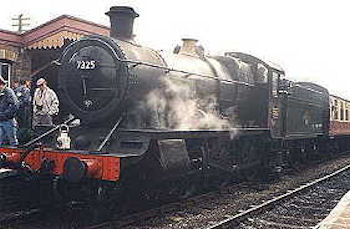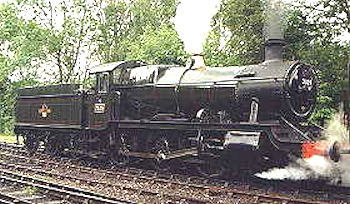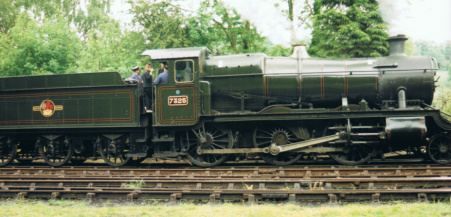
|
|
|
4300 class introduction
Running numbers: 4300 - 4399, 5300 - 5399 (renumbered 8300 - 8399 between 1944 and
1948), 6300 - 6399, 7300 - 7321, 9300 - 9319 (renumbered 7322 - 7341 between 1956 and 1959).
Built: 1911 (4301 - 4320) to lot number 183,
1913 (4321 - 4330) to lot number 193,
1913 (4331 - 4340) to lot number 194,
1913-14 (4341 - 4360) to lot number 198,
1915 (4361 - 4380) to lot number 202,
1916 (4300, 4381 - 4399) to lot number 204,
1916-17 (5300 - 5309) to lot number 205,
1917 (5310 - 5329) to lot number 206,
1917-18 (5330 - 5349) to lot number 207,
1918-19 (5350 - 5369) to lot number 208,
1919-20 (5370 - 5389) to lot number 209,
1920-21 (5390 - 5399, 6300 - 6317) to lot numer 211,
1913-22 (6318 - 6341) to lot number 212,
1913-22 (6370 - 6399, 7300 - 7304) Built by R. Stephenson to lot number 218,
1921-22 (7305 - 7319) to lot number 222,
1923 (6342 - 6361) to lot number 216,
1925 (6362 - 6369, 7320 - 7321) to lot number 230,
1932 (9300 - 9319) to lot number 276.
Great Western's maid of all work, the '4300' Mogul class, was first introduced in 1911 with the building of the prototype number 4301. Employing a Standard number 4 boiler and the support struts similar to those fitted to the '2800' class, it very quickly earned an excellent reputation in its ability to handle most types of traffic, from local stopping goods to main line expresses. Production itself followed on within the month of building number 4301, but it interesting to note that the first ten engines of the class were the last locomotives to carry the Swindon works plate under the smokebox. Also, this was the first class to be introduced with top feed as standard. The first twenty that were built remained slightly different from the rest of the class in that the frames of all other production engines were lengthened by 9 inches at the rear to give more access to the plumbing as well as more room in the cab.
first introduced in 1911 with the building of the prototype number 4301. Employing a Standard number 4 boiler and the support struts similar to those fitted to the '2800' class, it very quickly earned an excellent reputation in its ability to handle most types of traffic, from local stopping goods to main line expresses. Production itself followed on within the month of building number 4301, but it interesting to note that the first ten engines of the class were the last locomotives to carry the Swindon works plate under the smokebox. Also, this was the first class to be introduced with top feed as standard. The first twenty that were built remained slightly different from the rest of the class in that the frames of all other production engines were lengthened by 9 inches at the rear to give more access to the plumbing as well as more room in the cab.
Engines of 4300 and 5300 series had the right hand centre splasher elongated to accommodate not only the driving wheel but also the air pump whereas the 7300 and 9300 series the running plate was lengthened underneath the smokebox. The last twenty locomotives of the 9300 series built in 1932 were fitted with windows fitted in the cab side together with screw reversing gear.
Robert Stephenson built 35 engines of this class for the Great Western in 1921, numbers 6370 - 99 and 7300 - 04.
Eleven examples of the class were transported to France during World War I in the service of the Railway Operating Division of the British Army and these were 5319 - 5326 and 5328 - 5330.
of the class were transported to France during World War I in the service of the Railway Operating Division of the British Army and these were 5319 - 5326 and 5328 - 5330.
Modifications.
Between January and March 1928, 65 engines of 5300 series had weight added to pony truck to relieve wear on leading driver flanges. This added weight was in the form of a heavy casting mounted on the front buffer beam. This alteration was first tried on numbers 4351 / 4385 / 4386 / 4395, and when found to be successful, these four were renumbered 8300, 8334/5 and 8344 before quickly reverting back to their previous numbers. The 65 engines in question were numbers:
5300-2, 5304/5, 5307-9, 5313-15, 5318, 5320, 5322, 5325-29, 5331-35, 5337/8, 5340-44, 5350-54, 5357-66, 5368/9, 5372-74, 5376, 5378/9, 5381-84, 5386-91 and 5393. These were renumbered to the 83xx series but keeping the last two digits of the number. Therefore number 5326, although the 16th member of the 8300 class, became number 8326. However, these, engines reverted back to their original numbers when the cast iron weight was removed between 1944 and 1948. Similarly, engines numbered 9300 - 9319 were renumbered 7322 - 7341 when their weights were removed between 1956 and 1959.
engines reverted back to their original numbers when the cast iron weight was removed between 1944 and 1948. Similarly, engines numbered 9300 - 9319 were renumbered 7322 - 7341 when their weights were removed between 1956 and 1959.
Only one example of the class was converted to oil firing, number 6320, which ran in this condition from 1947 to August 1949.
One hundred and sixty-three members of the class were fitted with outside steam pipes and new cylinders between July 1928 and August 1958.
Withdrawal.
An unusual accident occurred to number 6315 when there was a breach in the Shropshire Union canal on the 7th of September 1944 causing the railway embankment near Llangollen to be washed away. The locomotive was repaired and returned to service until withdrawal in October 1945.
88 of the 4300 series and 12 of the 8300 series were withdrawn between 1936 and 1939, but their wheels and motion were used in the construction of the 'Grange' and 'Manor' 4 - 6 - 0 classes. The last three engines of the class were withdrawn in November 1964.
Preservation.
From a class of 342 locomotives, just 2 examples have been preserved, and they are numbers 5322 and 7325 (ex 9303).
Specifications (long cone boiler with superheater).
| Cylinders | (2) 18½ x 30 inches | Driving wheel diameter | 5 feet 8 inches | ||
| Bogie wheel diameter | 3 feet 2 inches | Tractive Effort | 25,670 pounds | ||
| Boiler type | Number 4 | Boiler maximum dia. | 5 feet 6 inches | ||
| Boiler minimum dia. | 4 feet 10¾ inches | Fire tubes, no. and dia. | 235 x 1 5/8 inches | ||
| Flue tubes, no. and dia. | 14 x 5 1/8 inches | Superheater tubes, no. and dia. | 84 x 1 inch | ||
| Boiler pressure | 200 lbs/square inch. | Boiler length | 11 feet 0 inches | ||
| Area of firegrate | 20.56 square feet | Heating surfaces, tubes | 1,349.64 square feet | ||
| Heating surfaces, firebox | 128.72 square feet | Heating surfaces, superheater | 191.79 square feet | ||
| Length | 58 ft 7¼ in | Total Weight (except 7322 - 7341) |
102 tons 0 cwt | ||
| Water Capacity | 3500 gallons | Total Weight (7322 - 7341 only) |
105 tons 6 cwt | ||
| Coal Capacity | 6 tons | G.W. Power Class | D | ||
| Route Availability (except 93xx class) |
Blue | BR Power Classification | 4-MT | ||
| Route Availability (93xx class only) |
Red |
Copyright © by John Daniel 2013.
